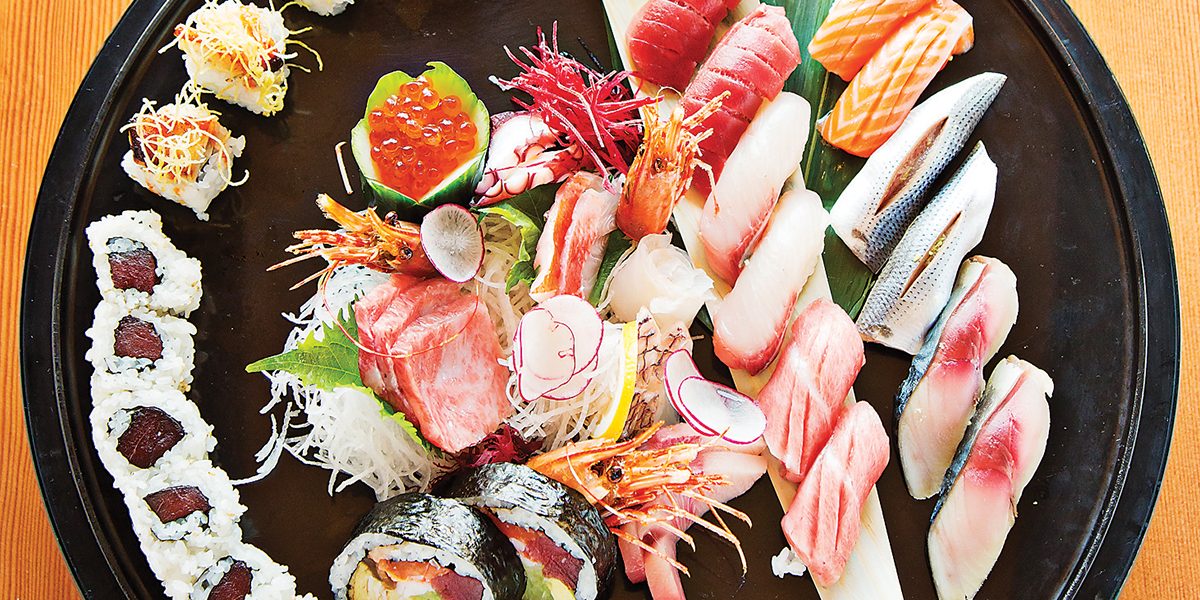Food & Drink
Gone Fishing
Ride the surf at Azumi.
Tug on the samurai sword door pull as you enter Azumi, move beyond the bar with Japanese characters laser-cut into a steel sheet, then pick your path: a faux eel-skin banquette in the lounge, the raw-fish bar gleaming with live sea urchin, or a booth with breathtaking views of the harbor.
Welcome to The Land of the Rising Sun by way of The Land of Pleasant Living.
When we heard that Alex Smith and his partner George Aligeorgas of the Atlas Restaurant Group (known for the Harbor East hotspot Ouzo Bay) decided to stick with the concept of Japanese fine-dining when Pabu closed on the same site last year, the comparisons from Pabu’s dedicated fan base—present company included—seemed inevitable.
Wisely, Smith and Aligeorgas kept what worked at the former izakaya (Japanese for pub), going so far as to rehire master sake sommelier Tiffany Dawn Soto to preside as a consultant over the beverage program, which boasts the best sake selection in the city. And they changed what didn’t—broadening the menu to encompass not only authentic Far East imports (live black tiger shrimp and baby octopus from the famed Tsukiji Market in Japan), but also more approachable fare such as cooked sushi rolls, rock shrimp, and even roasted free-range chicken for the inevitable finicky eater.
While Pabu was pretty, designer Patrick Sutton has slicked up the space for Azumi (think: Nobu, Morimoto, and other internationally known fish emporiums) and created a more fluid flow, while even the front door was hard to find at the former iteration.
When my dining companion and I arrived early on a Saturday night, the trendy house music was already in full force, and grown-up versions of the cool kids were holding court at the buzzy bar. Though our waitress was sweet, her understanding of the menu seemed mostly memorized, so, as was our habit at Pabu, we summoned Soto (who actually helped recruit chef Eiji Takase and lived in Japan for several years).
Our dining neighbor offered that the fish was as good as any he’d had while on a recent trip to Tokyo.
While Soto can wax rhapsodic over the sake selection, she is equally excited about helping design your dinner from a menu comprised of starters, sushi, entrees, niku (meat) and sides, as well as an omakase chef’s choice tasting menu. The tab can get high here in no time, so plan properly and take Soto’s unerring advice on the best way to move through your meal.
Since its opening in December, I’ve visited Azumi numerous times and have taken every tack, from sampling the bold (bite-sized Sawagani crabs flash-fried with sea salt and lime) to trying the more banal—though no less delicious—
age dashi tofu, which was crisp and impossibly soft and resting in a soy dashi broth.
On this visit, we ordered from almost every section of the menu, though it’s the fish dishes—served hot, cold, cooked, or raw—that rate. Our favorite appetizers included an exquisitely plated kanpachi amberjack glistening with black-truffle oil and a tangy yuzu juice served on a crisp yucca chip, and the exceptionally fresh blue-fin toro sashimi (flown in daily from Japan). We ordered ours nigiri-style, with the buttery belly meat blanketing a ball of rice, and served properly with a dab of wasabi tucked between the layers, so that no additional sauce was needed. As we savored each bite, our dining neighbor offered that the fish was as good as any he’d had while on a recent trip to Tokyo.
On the sushi side of the menu, we chose from among a list of more than a dozen unique rolls. Having found fish bliss with the miso-marinated black cod entrée on a previous visit, we were eager to try the black cod roll fortified with spicy miso, crispy satsumaimo (Japanese sweet potato), and a kick of shiso ginger. It was as pleasing to the eyes as it was to the taste buds. A plate of delicate Scottish salmon crudo garnished with beet threads and flower petals also astonished.
To go with our surf, we included some turf—in this case a Wagyu New York strip steak. Expectations ran high for the prized piece of rarified A5-grade beef served with three house-made, soy-based dipping sauces. While full-flavored, the intensely marbled meat was difficult to chew and made me wonder: Why $58? On an earlier visit, the Wagyu skirt steak—way more fairly priced at $29—was preferable to my palate (and my pocketbook).
The desserts are artful and elaborate, adorned with hand-spun sugar sculptures and 23-karat gold flakes, though the simplest one, a selection of house-made mochi ice creams (mango, green tea, yuzu), is the standout. Sad as I was to say sayonara to Pabu, there are, in fact, other fish in the sea. Or at least along the Patapsco.
